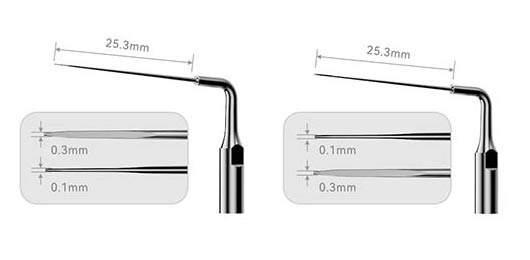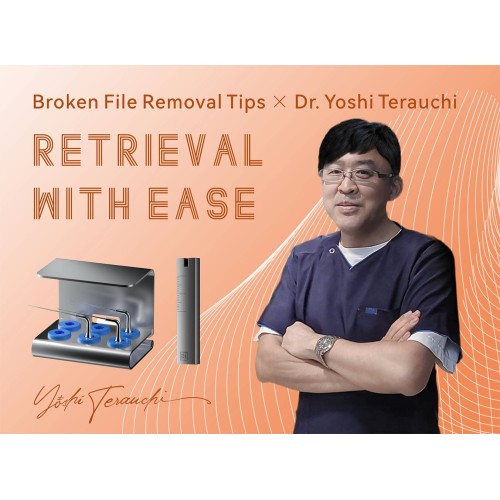WFRK-1 Broken Endo File Retrieval Kit includes -
ED87 (TFRK-S) Tip - Qty 1
ED88 Tip (Katana-V) - Qty 1
ED99 Tip (Katana H - Qty 1
Tip Holder - Qty 1
WFRK-2 Broken Endo File Retrieval Kit includes -
E87 (TFRK-S) Tip - Qty 1
E88 Tip (Katana-V) - Qty 1
E99 Tip (Katana H - Qty 1
Tip Holder - Qty 1
E87/ED87 (Jointly Developed with Dr. Yoshi Terauchi)Tip for broken file removal. $0.1mm tip head, extremely thin and conical, used to remove dentin around the broken file.
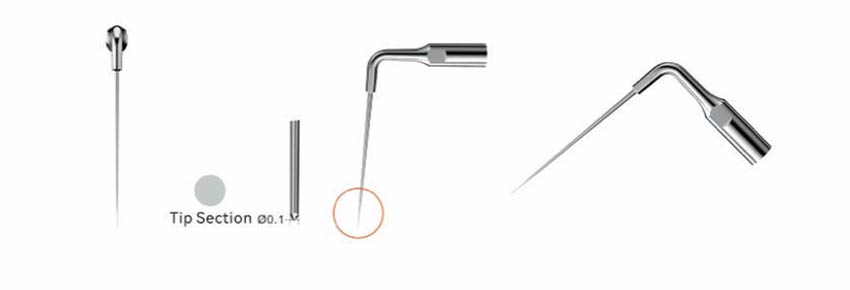
E88/ED88 (Jointly Developed with Dr. Yoshi Terauchi)
Tip for broken file removal. 0.1mm thickness tip head, extremely-thin sword shaped, front and back directed, used to remove dentin around the broken file.
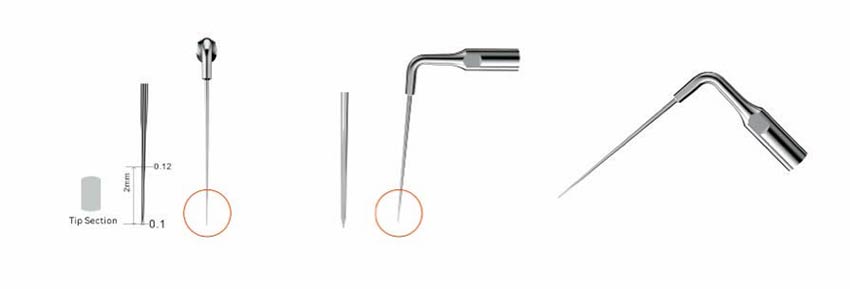
E89/ED89 (Jointly Developed with Dr. Yoshi Terauchi)
Tip for broken file removal. 0.1mm thickness tip head, extremely-thin sword shaped, left and right directed, used to remove dentin around the broken file.

How To Use
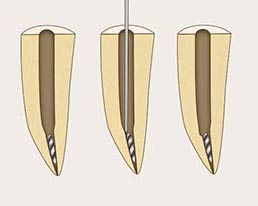
Step 1 - Canal enlargement to the broken file and flaring of the canal
Use the No.3 Gates Glidden bur to enlarge the canal to the broken file and brush it against the outer wall to flare the canal when the canal curvature is less than 15 degrees.
Use the No. 60/.02 taper NiTi file to enlarge the canal to the broken file and brush it against the outer wall to flare the canal when the canal curvature is greater than 15 degrees.
Use the No.3 Gates Glidden bur to enlarge the canal to the broken file and brush it against the outer wall to flare the canal when the canal curvature is less than 15 degrees.
Use the No. 60/.02 taper NiTi file to enlarge the canal to the broken file and brush it against the outer wall to flare the canal when the canal curvature is greater than 15 degrees.
Step 2 - Creating a 90-degree semicircular space
Use ED88 (Katana-H) and ED89 (Katana-V) to create thin space between the inner wall and the broken file. Direct the flat surface of the tip to the broken file from the inner wall and activate ultrasonics as it is placed in the space. The depth of the space should be at least one third of the length of the broken file. When the curvature is greater than 30 degrees, a drop of medical-grade silicone oil is placed in the canal to facilitate lubrication and loosening of the broken file. The depth of the space on this condition should be at least half the length of the broken file.
Use ED88 (Katana-H) and ED89 (Katana-V) to create thin space between the inner wall and the broken file. Direct the flat surface of the tip to the broken file from the inner wall and activate ultrasonics as it is placed in the space. The depth of the space should be at least one third of the length of the broken file. When the curvature is greater than 30 degrees, a drop of medical-grade silicone oil is placed in the canal to facilitate lubrication and loosening of the broken file. The depth of the space on this condition should be at least half the length of the broken file.
*Note: Activate ultrasonics as the tip is placed in the space for half a second, and deactivate ultrasonics as the tip is withdrawn from the space. Use the power setting as low as practical and increase the power only when it is not cutting any dentin. This procedure is crucial to prevent the secondary fracture of the broken file and breakage of the tip.
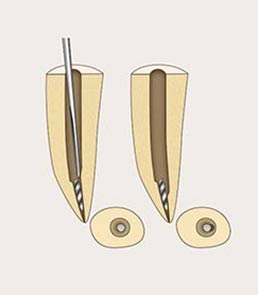
Step 3 - Extending the peripheral space from 90 degrees up to 180 degrees
Use ED87 (TFRK-S) to extend the 90-degree semicircular space to 180 degrees until the broken file is seen "dancing" (moving from the original space to another) under magnification. In clinical practice, the tip is used in pecking and pulsing motions to prevent the accident. Do not press the tip against the canal and activate ultrasonics because the tip will break due to cyclic fatigue. In order to laterally extend the space, the tip must be used in an up/down motion to cut dentin, not sideways.
Use ED87 (TFRK-S) to extend the 90-degree semicircular space to 180 degrees until the broken file is seen "dancing" (moving from the original space to another) under magnification. In clinical practice, the tip is used in pecking and pulsing motions to prevent the accident. Do not press the tip against the canal and activate ultrasonics because the tip will break due to cyclic fatigue. In order to laterally extend the space, the tip must be used in an up/down motion to cut dentin, not sideways.
*Note: A longer/larger broken file requires a more preparation time. If the broken file is seen moving to another place and returning to the original place, the preparation is not considered done and needs to continue until it is seen "dancing".
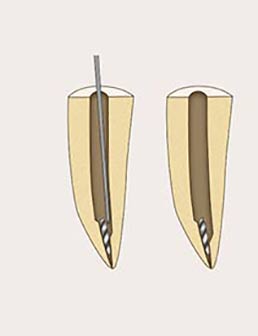
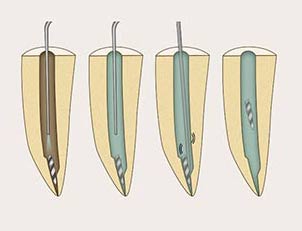
Step 4
After preparation is completed, use the ultrasonic tip used when the broken file was made to "dance" to make ultrasonic removal attempts. First, 17% EDTA is filled in the canal when the canal curvature is 30 degrees or less than 30 degrees, or vegetable oil such as soybean oil when the canal curvature is greater than 30 degrees. Place the ultrasonic tip into the space created on the inner wall and activate ultrasonics in a short vertical stroke within the prepared space until it is seen coming out of the canal.
After preparation is completed, use the ultrasonic tip used when the broken file was made to "dance" to make ultrasonic removal attempts. First, 17% EDTA is filled in the canal when the canal curvature is 30 degrees or less than 30 degrees, or vegetable oil such as soybean oil when the canal curvature is greater than 30 degrees. Place the ultrasonic tip into the space created on the inner wall and activate ultrasonics in a short vertical stroke within the prepared space until it is seen coming out of the canal.
Please use the minimum power level in the Endo Mode of the ultrasonic scaler
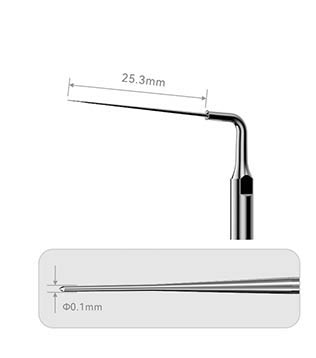

ED87 TFRK-S
The tip is characterized by an extremely sharp cone-shaped head: 0.1 mm diameter and 0.01 taper. (can be pre-curved according to the degrees of the root canal curvature)
Feature1: Extend the grooved space until the broken file is seen dancing after the creation of the 90-degree semicircular space on the inner wall with either Katana-V or Katana-H
Feature 2: Remove the broken file
Feature 3: Create a thin space for the introduction of the hand gutta-percha removal instrument and remove gutta-percha root filling
The tip is characterized by an extremely sharp cone-shaped head: 0.1 mm diameter and 0.01 taper. (can be pre-curved according to the degrees of the root canal curvature)
Feature1: Extend the grooved space until the broken file is seen dancing after the creation of the 90-degree semicircular space on the inner wall with either Katana-V or Katana-H
Feature 2: Remove the broken file
Feature 3: Create a thin space for the introduction of the hand gutta-percha removal instrument and remove gutta-percha root filling
ED88 Katana-V ED89 Katana-H
The ultrasonic tips are designed with an extremely thin sword-shaped head. Activate ultrasonics with the flat surface directed to the broken file from the inner wall of the canal (can be pre-curved according to the degrees of the root canal curvature)
Feature: Create a 90-degree semicircular grooved space
The ultrasonic tips are designed with an extremely thin sword-shaped head. Activate ultrasonics with the flat surface directed to the broken file from the inner wall of the canal (can be pre-curved according to the degrees of the root canal curvature)
Feature: Create a 90-degree semicircular grooved space
